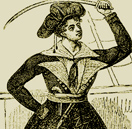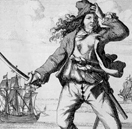
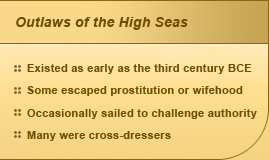
On a blustery day in the mid-1500s, Irish pirate Grace O’Malley lay exhausted belowdecks, recovering from the birth of her fourth child the day before. As she cradled the newborn, she heard sounds of struggle above—the ship was under attack by Algerian pirates. She listened hopefully for signs of her crew’s victory, but the pitiful cries for help from her men were the only sounds she recognized.
Finally, O’Malley put down her baby and picked up a pistol and cutlass to join the fight. Discharging her pistol into the crowd to clear a path, she cried, “May you be seven times worse off this day twelve months, who cannot do without me one day.” Seeing her fallen comrades, chieftain O’Malley forgot the pain of childbirth as her cutlass repeatedly found its mark, slicing a throat here, plunging into a belly there. Parrying with her emptied pistol, she slashed her blade across one last neck, and the ship was saved.
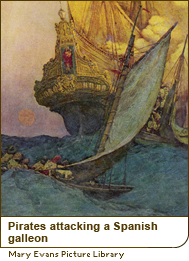 Historically, men weren’t the only ones wreaking havoc and looting ships on the high seas. Armed with weapons and a hunger for adventure, women also ventured into treacherous waters as early as the third century BCE. They came from various social groups—peasants, thieves, rebels, cross-dressers, mothers and queens—and tales of their conquests exist around the globe: Asia, Europe, North Africa and the Americas.
Historically, men weren’t the only ones wreaking havoc and looting ships on the high seas. Armed with weapons and a hunger for adventure, women also ventured into treacherous waters as early as the third century BCE. They came from various social groups—peasants, thieves, rebels, cross-dressers, mothers and queens—and tales of their conquests exist around the globe: Asia, Europe, North Africa and the Americas.
Why did these women choose a life of crime at sea? For many, piracy offered an exciting escape from dreary or stifling lives. (From 1600 to 1800, wife, servant or prostitute were the only roles open to women on land.) Other women took up piracy or privateering to expand their empires, do battle with enemy governments or simply for the booty—sometimes even leading raids with their breasts bared to distract male enemies.
Drama at Sea
The folklore and mythology of ancient cultures worldwide feature several females whose realm was the ocean. Pisinoe, Aglaope and Thelxiepi, the Sirens of Greek mythology, lured mariners into destructive crashes against the rocks surrounding their island home by singing beautiful melodies. In Japan, there is the folktale of Tokoyo, the teenage daughter of a samurai, who single-handedly slayed an evil sea serpent. Ancient Chinese legend tells of Ch’iao K’uo Fu Jen, a female pirate who sailed circa 600 BCE and famously liberated a young girl who had been abducted by foreign sea bandits.
While most dismiss such legends as fiction, there are also historical accounts of women who took to the seas with a vengeance. In Illyria, a warrior-queen named Teuta assumed the throne after her husband died circa 231 BCE. Her first course of action as ruler was to turn the Illyrian navy into a privateer fleet and authorize it to “plunder all whom they fell in with,” according to Polybius. Not content to rule from a distance, Teuta accompanied her privateers on several raids, ravaging the coastline so voraciously that Illyria soon controlled most of the Mediterranean coast.
In the ninth century CE, the beautiful Viking Alfhild turned to piracy for a very different reason—to evade marriage. She donned men’s clothes and headed to the Baltic and North seas with her female friend and assistant Groa to lead a roving bandit gang composed of male and female pirates.
Gathering Booty
Female pirates of all classes were rampant in Elizabethan Britain. Some impoverished plunderers waded into the Thames River to sneak onto close-to-shore vessels, while more ladylike pirates such as Lady Mary Killigrew took to the Cornish seas. Killigrew was born into a family of “gentleman pirates”—privileged privateers—and married into another. She was charged with parceling out the booty her husband’s crew brought to shore and commanded at least one raid herself.
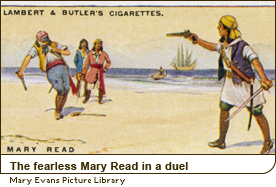 Meanwhile, Ireland’s favorite pirate, Grace O'Malley (or Granuaile), was raiding English merchant ships, proudly creating trouble for what she and her peasant fleet saw as an oppressive English state. A wife and mother who is remembered as a magnificent sea-warrior, O’Malley is famous for her speed and agility in battle—and her near-miraculous ability to “disappear” into the curves of the Irish coastline. This remarkable pirate plundered well into her 70s, surviving several husbands and a prison sentence.
Meanwhile, Ireland’s favorite pirate, Grace O'Malley (or Granuaile), was raiding English merchant ships, proudly creating trouble for what she and her peasant fleet saw as an oppressive English state. A wife and mother who is remembered as a magnificent sea-warrior, O’Malley is famous for her speed and agility in battle—and her near-miraculous ability to “disappear” into the curves of the Irish coastline. This remarkable pirate plundered well into her 70s, surviving several husbands and a prison sentence.
During the Golden Age of Piracy, women worldwide took to the high seas. In India, a queen whose name has been lost to history commanded a large fleet of pirate ships. To the west, Moorish Sayyida al-Hurra responded to Spain’s expulsion of her people by raiding Spanish ships.
Later in the Golden Age, Mary Read and Anne Bonny raided ships in the Caribbean. The adventure-seeking Read, who started her life at sea dressed as a boy on a British warship, repeatedly abandoned legitimate seafaring (on a merchant vessel; as a privateer) for piracy. She and Bonny, known together as “a brace of hellcats,” fought fiercely, wielding cutlasses and pistols, on John “Calico Jack” Rackham’s ship.
In the 1800s in the South China Sea, prostitute-turned-pirate Cheng I Sao controlled more ships (2,000) and more pirates (80,000-plus) than any other pirate in history. On her ships any pirate who stole from the common treasury or raped a female captive (a typical action of male pirates) faced the harshest punishment: beheading.
In author Sara Lorimer’s Booty: Girl Pirates on the High Seas, she notes, “When the time came for fighting, Madame Cheng’s pirates, known as the ‘wasps of the ocean,’ had a well-earned reputation for ferocity. Merchant crews who resisted were tortured horribly and left as a lesson to others, and navy sailors met gruesome deaths whether they resisted or not.” Like O’Malley, Cheng I Sao built her fleet from hungry and starving masses who felt no debt of loyalty to the oppressive government whose ships they attacked.
During the 1930s, another Asian pirate, Lai Choi San, commanded a dozen armored junks in the seas surrounding Macao, with two female attendants by her side.
Pirates Go Pop
With so many exciting stories of female pirates, it is no wonder they have long captivated the popular imagination. Seafaring female outlaws have appeared in literature and on-screen for centuries: from Captain Charles Johnson’s controversial A General History of the Robberies and Murders of the Most Notorious Pirates (1726), which features Bonny and Read, to films such as Against All Flags (1952), Captain Kidd and the Slave Girl (1954) and Le Avventure di Mary Read (1961).
In recent years, the escapades of fictional pirate Connie Blackheart were at the center of the short-lived British TV comedy series Tales From the Poop Deck (1992). 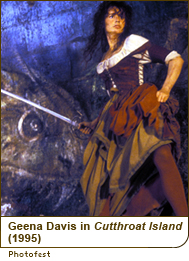 Actress-athlete Geena Davis had her fun on the high seas portraying Morgan Adams, a pirate in control of her own ship, in the action film Cutthroat Island (1995). And up-and-coming actress Zoe Saldana entertained audiences as Anamaria, the fierce, scene-stealing pirate—and only woman—in Captain Jack Sparrow’s crew in the box-office hit Pirates of the Caribbean: The Curse of the Black Pearl (2003).
Actress-athlete Geena Davis had her fun on the high seas portraying Morgan Adams, a pirate in control of her own ship, in the action film Cutthroat Island (1995). And up-and-coming actress Zoe Saldana entertained audiences as Anamaria, the fierce, scene-stealing pirate—and only woman—in Captain Jack Sparrow’s crew in the box-office hit Pirates of the Caribbean: The Curse of the Black Pearl (2003).
Venturing into wild, dangerous waters, women throughout history have fought and plundered alongside male pirates—sometimes even taking the helm—with boundless courage. Whether real or imagined, tales of female swashbucklers will continue to be embraced by readers and audiences who can’t get enough of their love for adventure, struggle for justice or pure lust for booty.
:: woa.tv staff
Pirates Selected Sources


